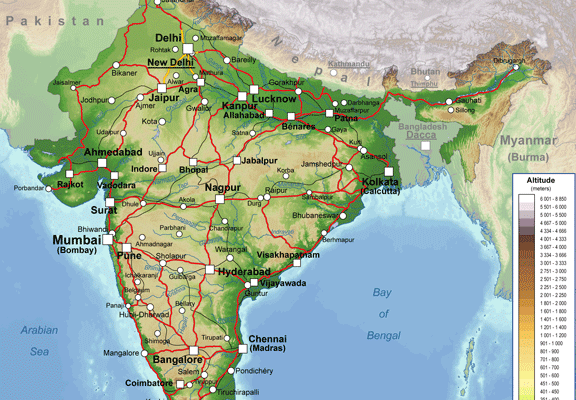Restoration of India’s rivers can help in attaining water security
and promote sustainable livelihood, particularly for the deprived
sections of the country’s large rural population.
Most rivers in the country have progressively degraded in quality due to rapidly increasing waste input from different sources, exacerbated with reduced flows, primarily due to large water diversion for multi-sector use.
Multiplicity of uses often conflicts with environmental concern. River
restoration, with time dependant recovery, require committed long term
approach, supported with hydrologic, quality of water and
socio-economic studies to identify causes, contaminant sources and
polluted stretches in order to plan compatible measures.
Restoration efforts face both natural and human induced constraints
including varied hydro-climatic zones in the country, climatic
vicissitudes, and anthropogenic actions producing undesirable situation.
Intensity and duration of rainfall varies widely in this vast country,
from humid Meghalaya to arid Rajasthan, which has an unmistaken impact
upon the flow regime. Major (12) and medium (48) rivers have been
recognized, depending upon climatic condition, geographical locations
and size of catchment, which reportedly contribute nearly 85 per cent of
the total flow.
River courses, particularly perennial ones, may derive their water from
multiple sources, such as catchment precipitation, snow/glacier melt,
effluent streams and tributaries. Climatic changes can modify
precipitation pattern, affecting runoff.
Ecological degradation can be inferred from enhanced biological oxygen
demand (BOD), low levels of dissolved oxygen (DO), increase in toxic
concentration of heavy metals, pathogens, load of organics including
hydrocarbons and pesticides etc.
These changes could occur due to disposal of raw or partially treated
sewage containing organic, inorganic and hazardous waste through various
modes on river stretches. Open defecation, disposal of dead bodies and
carcasses of animals, encroachments in flood plains, infrastructure
affecting river course, agrarian activities and erosion are among other
causes.
The polluted river waters create unfavourable habitat for the aquatic
species such as fish, turtles etc and affect the livelihood of dependant
communities, engaging in fisheries, boat / barge operation,
cultivation, livestock rearing, among others. The use of degraded river
water quality also affects human health, exposing vulnerable population
to water borne diseases, besides endangering animal health as well as
survival of aquatic biota.
Improvement in quantity and quality of river water and the ecological
habitat therein, is attainable by applying available technology of waste
containment, barring input along with waste dilution and dispersal by
allowing sufficient natural flows for waste assimilation.
Waste generation e.g. municipal sewage and industrial effluents &
emissions need to be curbed, as per existing guidelines. Agricultural
activities including large use of irrigation water, overspreading
chemical fertilizers, crop pesticides can contribute significantly in
water quality decline. Waste can also travel from surface and shallow
aquifer routes.
Although natural flow is impeded by dams, barrages, flood protection
structures and river course modification etc, voluminous short-span
precipitation and runoff during monsoon necessitates their storage in
dam reservoirs for utilization during lean flow or dry period.
Uncontrolled massive load of sediments, debris and other land originated
suspended and dissolved matters in flood waters needs to be regulated
and minimized. Pollution loads from municipal, agricultural, industrial
and other watershed sources including storm water, need proper
evaluation for developing preventive and remediation methodology.
Concerted effort is required in implementing guidelines, policies and
planned restorative actions together with sufficient financial infusion.
Among the corrective actions may include adopting conservation
procedures, including bank stabilization, forestation and preserving
surrounding wetlands and flood plains etc, managing storm water
inflow to minimize watershed washout, systematic coverage of
urban, semi-urban or rural settlements’ solid waste & wastewater
collection and efficient operation of sewage treatment plants of
sufficient capacity at anomalous locations, planned reuse of
treated effluents on the land for non- domestic purposes with risk
assessment, and sensitizing riparian communities and the public at
large in sanitation and hygiene for sustainable river utilization.
River use planning with emphasis upon the conservation of river water in
all its usage should entail entire catchment, since partial approach is
likely to be insufficient in a populous scenario.
The river management structure, therefore, may need a relook, in view of
seemingly fragmented nature of water resources responsibilities
undertaken by different agencies, both at state and Central levels.
An inclusive management strategy in cooperation with riparian states and
stakeholder communities, may need to be established for each
hydrological basin, some of which may even extend beyond state
boundaries and national borders. Taking riparian communities into
confidence, holistic planning should be able to integrate genuine
ecological concern with sustainable development.
Knowledge-based social awareness campaign leading to habit change,
respecting pollution bye-laws, formation of people’s interest groups are
among more notables to be carried out by civic bodies/administration in
coordination with people at local levels.
(Author's comment: The article is developed on the premise that
persisting river use problems in the river basin and their causes needed
to be clarified for the purpose of developing and / or reviewing
effective restoration programme. Most information is derived from
different published and on line sources, including agencies data,
observations and experience for which the author is truly indebted.)
By Dr Rashid Ali Khan former Water Resources Expert with Food & Agriculture Organization of the United Nations (FAO)@India Water Review

No comments:
Post a Comment